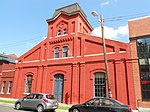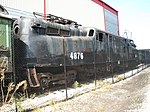"Pigtown", also known as "Washington Village" is a neighborhood in the southwest area of Baltimore, bordered by Martin Luther King Jr. Boulevard to the east, Monroe Street to the west, Russell Street to the south, and West Pratt Street to the north. The neighborhood acquired its name during the second half of the 19th century, when the area was the site of butcher shops and meat packing plants to process pigs transported from the Midwest on the B&O Railroad; they were herded across Ostend and Cross Streets to be slaughtered and processed.Pigtown's annual festival famously features a pig race, called "The Squeakness", to commemorate its history.Pigtown has long been considered one of Baltimore's most promising neighborhoods due to its proximity to the I-95 corridor, the University of Maryland Medical Center, Camden Yards, Ravens Stadium, the Inner Harbor, and Downtown Baltimore. New developments on the eastern edge of the neighborhood of luxury townhomes were stalled after the 2008 market crash but eventually resumed and have continued into 2016. Other parts of the neighborhood contain classic Baltimore-style rowhouses, often with 1950s-era formstone facades on brick fronts.
Pigtown has a relatively diverse population, which, besides its longtime residents, includes a sizeable graduate student population. Because of its proximity to Interstate 95, the Baltimore-Washington Parkway, MARC's Camden Station, and its low housing costs, Pigtown also has a great number of commuters to Washington, D.C., and Fort George G. Meade. The legendary baseball player Babe Ruth was born and raised in Pigtown.










